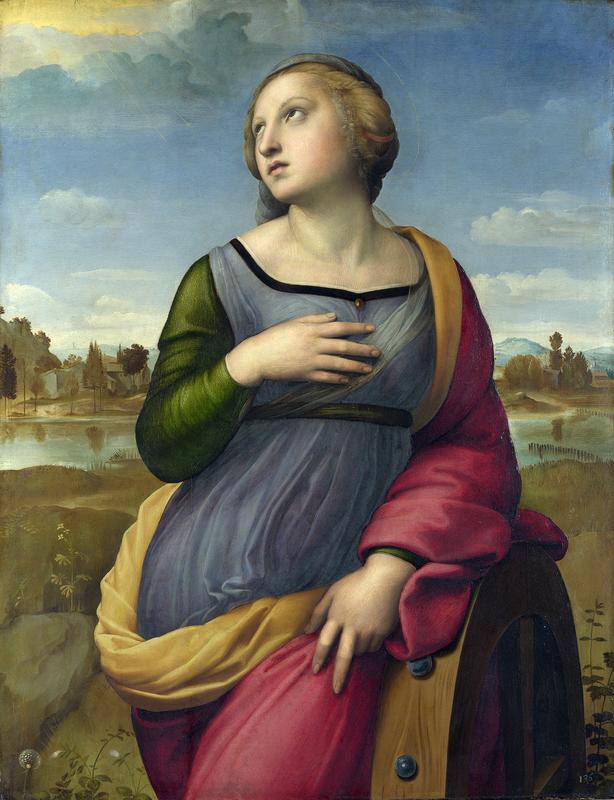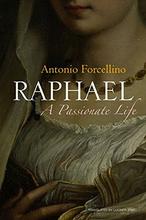More about Saint Catherine of Alexandria
- All
- Info
- Shop

Contributor
The depicted St. Catherine of Alexandria began her life like so many famous people do, as a prodigy and a learned lady of the sciences.
But, at the age of eighteen she would grow up much faster than I did at my private high school. She would be confronting the Roman Emperor at the same age that I was calculating the projection angles of launched water balloons, playing guitar in intermediate jazz band, and failing to get dates to dances.
As a teenager, Saint Catherine had a vision of the Madonna and child Jesus, and she immediately converted to Christianity as a result (which was not exactly a popular move at the turn of the fourth century). Then, perhaps because she was at the apex of her irrational, teenage, decision-making years (18), she took her newfound knowledge directly to Roman Emperor Maxentius, who was condemning and killing Christians left and right. Instead of killing her, Maxentius argued with her and lost. Frustrated, he ordered 50 of his greatest orators and philosophers to debate her about Christianity. This of course raises a huge side question: why would the Emperor have, need, and use 50 philosophers to debate an 18-year-old girl? But anyway, the 50 philosophers lost clearly and decisively to young Catherine. Some of the philosophers were even said to have converted to Christianity on the spot (and were subsequently executed). So then Maxentius, the sore loser, decided to seek petty revenge by making Catherine a sore winner. She was beaten publicly and then imprisoned without food for days. Luckily, she received help from angels who tended to her wounds and fed her until she exited the prison looking more beautiful than ever. While in prison, countless people visited her and converted to Christianity (the most notable of the converts being the Emperor’s own wife).
It was after all of this transpired that things took a turn for the crazy. Emperor Maxentius decided to propose to St. Catherine. Just adding my two cents here--I think he would have had a much better chance of succeeding in his proposal if he had not already ordered her to be scourged, imprisoned, and starved. Catherine dropped a bomb on Emperor Maxentius in response, telling him that actually she was already married to a guy named Jesus and she would therefore never marry another. Understandably Maxentius was humiliated, worse than getting rejected on the Jumbotron, and he decided to take his anger out on Catherine again (since it worked so well for him the first time). He ordered death by spiky wheel (pictured above as one of her identifying attributes), but when Catherine touched it, the entire wheel shattered. Then Maxentius ordered death by beheading, and the legend says that Catherine accepted this death as her choice. When her head was subsequently chopped off, a milk-like substance flowed from her body instead of blood.
The painting of St. Catherine of Alexandria comes from the tail end of Raphael’s time in Florence, before he moved to Rome. As a young artist, Raphael was heavily influenced by other Florentine artists like Leonardo da Vinci and Michelangelo, and in this work, St. Catherine’s pose over the spiked wheel is supposed to be reminiscent of Leonardo’s Leda and the Swan. The piece sold about twenty years ago to the Italian Government for $1.65 million, the most ever for a Raphael painting sold at an auction.
Sources
- "St. Catherine of Alexandria." CATHOLIC ENCYCLOPEDIA: Miguel Hidalgo. Accessed July 25, 2018. http://www.newadvent.org/cathen/03445a.htm.
- Reif, Rita. "Marcoses' Raphael Sold To Italy for $1.65 Million." The New York Times. January 12, 1991. Accessed July 25, 2018. https://www.nytimes.com/1991/01/12/arts/marcoses-raphael-sold-to-italy-….
- "St. Catherine of Alexandria." Encyclopædia Britannica. March 28, 2017. Accessed July 25, 2018. https://www.britannica.com/biography/Saint-Catherine-of-Alexandria.

Featured Books & Academic Sources
The following is an excerpt from "Raphael: A Collection of Fifteen Pictures and a Portrait of the Painter with Introduction and Interpretation" by Estelle M. Hurll, published in 1899:
This is the legend of St. Catherine.
She was the daughter of King Costis and his wife Sabinella, who was herself the daughter of the king of Egypt. When she came into the world, a glory of light was seen to play around her head, and when she was yet a little child, she gave such signs of wisdom that she was a wonder to all about the court of Egypt. When she was no more than fourteen years old, she was a marvel of learning. She could have answered all the hard questions the Queen of Sheba asked Solomon, and she knew her Plato by heart.
At this time her father died, and so Catherine became queen; but this did not change her way of living. She read her books and shut herself up in the palace to study. Now this did not please her nobles, and they besought her to take a husband who should help her rule the people, and who should lead them in war. At this the girl asked them:—
"What manner of man is this that I must marry?" And one of the nobles made answer:—
"Madam, you are our sovereign lady and queen, and all the world knows that you have four notable gifts. First, you are come of the most noble blood in the whole world; second, you have a great inheritance in your kingdom; third, you surpass all persons living in knowledge; and fourth, you are most beautiful. So, then, you must needs take a husband that you may have an heir who shall be the comfort and joy of your people."
"Is it indeed so?" said the young queen. "Then, if God has given me such gifts, I am the more bound to love him and please him, and set small store by my wisdom and beauty and riches and birth. He that shall be my husband must also possess four notable gifts. He must be of so noble blood, that all men shall worship him, and so great that I shall never think I have made him king; so rich, that he will surpass all others in riches; so full of beauty, that the angels of God will desire to behold him; and so benign, that he will gladly forgive all wrong done unto him. Find me such an one, and I will make him lord of my heart."
Now there was a certain hermit who dwelt in the desert about two days' journey from Alexandria, and the Virgin Mary appeared to him and bade him go and tell Catherine to fear not, for she should have a heavenly bridegroom, even her Son, who was greater than any monarch of the world, being himself the King of Glory, and the Lord of all power.
Until now the young queen had been a heathen, but when the hermit showed her a picture of the Lord Christ, she was so filled with wonder and devotion that she forgot her books and her learning and could think only of him. And thus it came about that she had a strange dream, in which she dreamt that she was brought to the Lord, and he said, "She is not fair or beautiful enough for me."
She woke in tears and sent for the hermit, who came and taught her the Christian faith. She was baptized and her mother Sabinella with her. Again she had a dream, and this time the Lord smiled on her, and put a ring on her finger.
So now Catherine despised still more earthly pomp and riches, and being thus plighted to a heavenly bridegroom, she refused more steadfastly all the attempts of her nobles to persuade her to be married. The good Sabinella sustained her in this, but at last died, and Catherine was now left alone.
Then came the great emperor Maximin, who persecuted the Christians. And he came to Alexandria and called the Christians together, and commanded them, on pain of torment, to worship the heathen gods. When Queen Catherine heard the uproar, she came forth of the palace and stood before Maximin. She so used her learning, that she silenced the emperor, and he could make no reply.
Thereupon he ordered fifty of his most famous wise men to dispute with her. But she answered them so convincingly that they themselves became Christians, and Maximin was in such a rage that he burned them to death, yet they did not flinch.
Then did the emperor drag Catherine from her palace and cast her into a dungeon. But the faithful queen prayed, and angels came and ministered to her. At the end of twelve days the empress came to visit her, and found the dungeon filled with light and fragrant with sweet odors. So she and two hundred of her attendants fell down at the feet of Catherine and declared themselves Christians.
When Maximin found what had taken place he was filled with fury, and put to death the empress and all the converts. But he was so overcome with the beauty of Catherine that he offered to make her empress if she would forsake Christ.
When Catherine exclaimed: "Shall I forsake my glorious heavenly bridegroom to unite myself with thee, who art base-born, wicked, and deformed?" Then Maximin bade his men make four wheels, armed with sharp points and blades, two turning in one direction, two in another, so that the tender body of the beautiful queen should be torn asunder.
So they bound her between the wheels, and at the same moment fire came down from heaven, and the destroying angel broke the wheels in pieces, which flew off and killed the executioner.
Then Maximin, with his heart of stone, commanded that Catherine be carried outside the city, and scourged and then beheaded. So it was done; but when she was dead, angels bore her body over the desert and over the Red Sea, and laid it away on the top of Mt. Sinai. As for the tyrant, he was slain in battle, and the vultures devoured him.
In our picture of St. Catherine, and in others like it, she is shown standing by a wheel. She leans upon it as if ready for martyrdom, and looks upward as if she saw the fire coming down from heaven.
Sources
- Hurll, Estelle M. "Raphael: A Collection of Fifteen Pictures and a Portrait of the Painter with Introduction and Interpretation" (Boston and New York: HOUGHTON MIFFLIN COMPANY, 1899.) 43-48
Featured Content
Here is what Wikipedia says about Saint Catherine of Alexandria (Raphael)

Saint Catherine of Alexandria is a painting by the Italian Renaissance artist Raphael. In the painting, Catherine of Alexandria is looking upward in ecstasy and leaning on a wheel, an allusion to the breaking wheel (or Catherine wheel) of her martyrdom.
It was painted c. 1507–1509, towards the end of Raphael's sojourn in Florence, and shows the young artist in a transitional phase. The depiction of religious passion in the painting is still reminiscent of Pietro Perugino, but the graceful contrapposto of Catherine's pose is typical of the influence of Leonardo da Vinci on Raphael, and is believed to be an echo of Leonardo's lost painting Leda and the Swan.
Check out the full Wikipedia article about Saint Catherine of Alexandria (Raphael)













